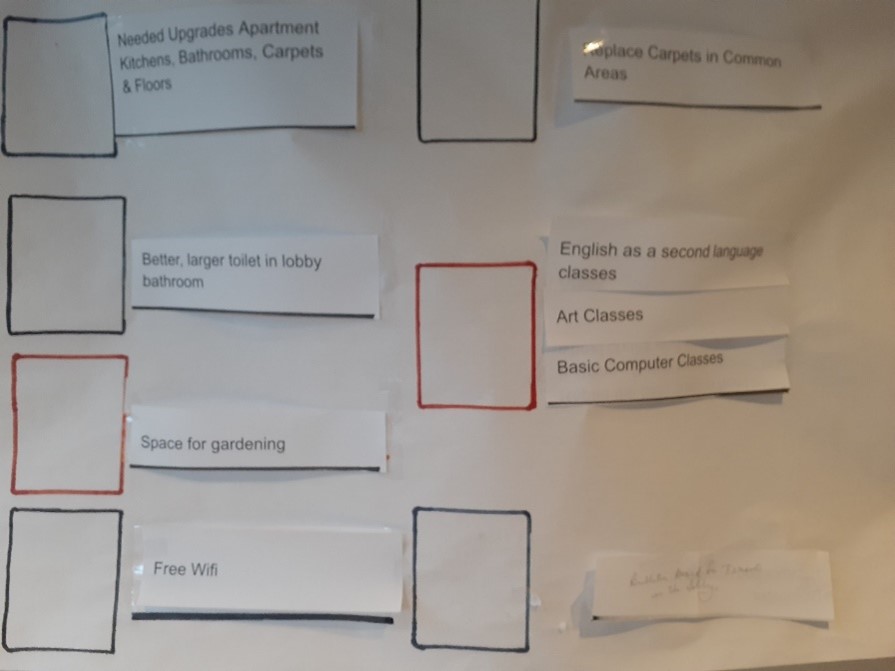 In public housing, most decisions are made by the Housing Authority’s Executive Director (ED). The good news is that an officially recognized Local Tenant Organization has the right to meet with the ED every three months. Many meet monthly, and we recommend that you do so if possible. To get the most out of your meetings with the ED, many tenants use the following five steps called the “Blueprint for Change.”
In public housing, most decisions are made by the Housing Authority’s Executive Director (ED). The good news is that an officially recognized Local Tenant Organization has the right to meet with the ED every three months. Many meet monthly, and we recommend that you do so if possible. To get the most out of your meetings with the ED, many tenants use the following five steps called the “Blueprint for Change.”
Step 1: Identify the Widely and Deeply Felt Issues
To create change in your building, residents will need to be organized. The first step to getting organized is to build relationships and find out what other residents care about. Which issues keep them up at night? Are some of these issues widely felt?
To find out what people care about, you need to ask them. There are lots of ways to do this. You can use door-knocking, phone calls, one-to-one meetings, accidental run-ins, surveys, community meetings and more to find out which issues are widely and deeply felt in the community. We’ll talk a lot more about this in our final session.
Widely felt means that many people care about the issue.
Deeply felt means that people care a lot and might even be losing sleep about the issue.
Step 2: Meet with Residents and Conduct the Dot Exercise
Once you have talked to as many neighbors as possible, you can bring everyone together to do a “Dot Exercise.” This will allow neighbors to collectively prioritize which issues they want to work on. We will cover this and the following steps in more detail in Part II of the Mel King Institute training.
Here is a snapshot of how the Dot Exercise works:
- At a meeting, genrrate a list of issues from residents, such as parking, sanitation, safety, schooling, etc. on a whiteboard or easel.
- Once you have a full list, count the number of issues.
- Divide the number by three. Give each resident this number of stickers. For example, if twelve issues are listed, each resident gets four
- Residents can then place the stickers next to the issues they think are most important. They can place them all next to one issue, or spread them out.
- Review the stickers to get a snapshot of which issues are most widely felt.
Step 3: Prep to Meet with the Executive Director (ED)
- Set a standard time for your meeting with the ED, for example every third Monday of the month.
- Set a standard time for the LTO Board to prepare for the meeting, for example the Friday before the meeting.
- At the prep meeting, review any commitments the ED has already made and be prepared to follow up.
- Prepare the list of goals (new or ongoing) and questions you will raise. This will be informed by Steps 1 and 2 above.
- Decide who will speak about what.
No one should attend the meeting with the ED unless they attend the prep session. No one should bring up an issue unless it has been approved by the group.
Step 4: Meet with the Executive Director
- Stick to your prepared agenda.
- Write down everything the ED says, especially what she or he promises to do in response to your goals. It is essential to keep track of whether the ED says yes, no, or maybe.
- Don’t feel pressure to solve the Housing Authority’s obstacles. Present your goals and keep presenting them until you win or change your goal. See the sidebar.
Step 5: Report Back through the Newsletter
As soon as possible after the meeting, write up the newsletter to report to the rest of the community about how things went.
- Share the issues that were discussed and what the ED said she or he would do about them.
- Make the newsletter as fun and accessible as possible. Use clip art or other graphics.
- This written record is extremely important for two reasons. First, it holds the Housing Authority accountable. Secondly, it provides transparency, so all residents know what is going on.
Results
- Tenants have resolved many issues as a result of this process.
- With each small or medium-sized victory, quality of life improves. Often, the atmosphere in the building becomes more “homey,” and the power of the tenant organization grows.
- As the tenants build more power, they will be able to tackle bigger and bigger problems.
